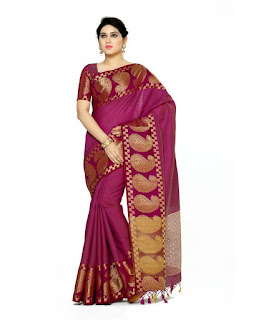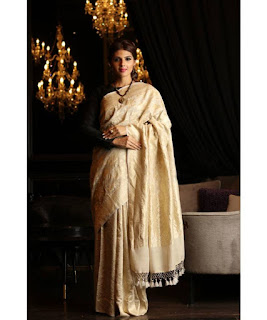The smooth and luxurious fabric of silk is something all Indian women love. IT is perhaps the richest fabric that embers a subtle glow that touches the heart and captivates the mind. If you too are a lover of silk, like I am, let us get to know more about this fabric in detail.
The Fabric and Its Varieties
We often talk about 'kanjivaram' and 'benarasi' sarees and refer to the as silks. But did you know that these names do not indicate the type o fabric used, but is based on the type of designs and embellishments?
Well, to further shed light on this thought, in India, there are four main types of silks. They are:
Mulberry Silk
 |
Mulberry Silk |
This is the richest variety of silk that goes into making the kanjivaram sarees and other south silks. The mulberry silks sarees are soft and have a texture to die for. The threads are long with a fine texture. Also, this type of silk costs the most, and you will find it in many variants. The mulberry silks last for decades while maintaining their sheen.
Tussar Silk
 |
Tussar Silk |
The Tussar silk is also called 'wild silk' in India. The reason? It is because this type of silkworms is found in the wilderness of the eastern zone of India. Thee have a dee golden tone and are used to make the bhagalpuri silks that we all so love.
Eri Silk
 |
Eri Silk |
The Eri silk is also called the 'non-violence or ahimsa silk.' The threads of this type of silks are short, one reason for being so is, it is obtained without killing the silkworm. The Eri silk generally hails from the eastern zone of Assam. This type of silk is not used for in making sarees, but owning to the coarse texture of Eri silk, it is used to make fine quality upholsteries.
The Muga Silk
 |
The Muga Silk |
Did you know that the Muga silk is the most durable among all the silk variants? Yes, this type of silk hail from the state of Assam too and has a distinct golden tone. The Assamese people use it to weave their traditional attire, -Mekhla Chador.
A Brief History of Silk
It is believed that silk originated in China. We find prominent references of silk during the Indus Valley Civilization. This fabric has played a major role in the trade between India dnChine since centuries. Towards the beginning of time, this fabric was reserved exclusively for royalty. Even till today, silks are highly-priced in India, and good quality silks typically do not fit a poor man's budget.
Today India is one of the largest producers in India. Besides being a producer herself, our country is also one of the largest consumers.
Silk: The Versatile Yarn
Silk: The Versatile Yarn
If you are a lover of saree, you would know how beautiful silk looks on women. Let us have a look at the versatility of this fabric.
Silk for Formal Wear
Silk for Formal Wear
A plain saree with a simple border can in silk looks very sober and is perfect for formal wear. You can as well wear silk sarees without border. Just team it up with a colored blouse or a boat neck blouse to make it a perfect formal attire.
Silk Saree for Wedding
Silk Saree for Wedding
Silks sarees of various kinds are loved and revered by brides. The most common wedding attire is a silk saree with golden thread work in red. You can as well choose blue, green, magenta or white silk sarees for your wedding day.
Silk Sarees for Parties
Silk Sarees for Parties
Team any silk saree with a sleeveless blouse and you are good to rock a party like a dive. Just make sure that you do not go overboard with accessorizing.
